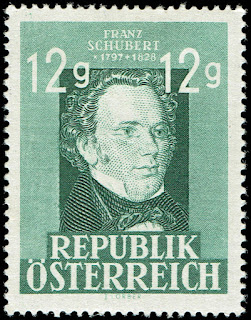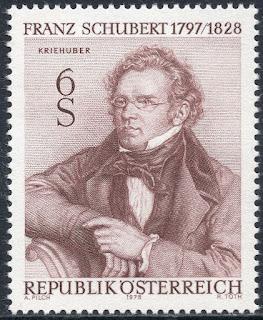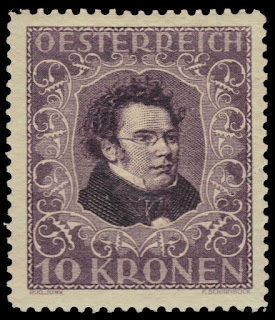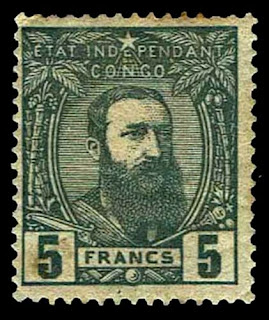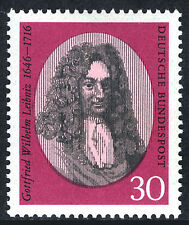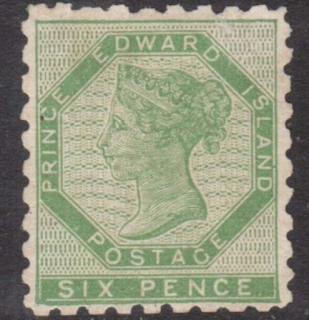1865 – First performance of the Unfinished Symphony by Franz Schubert.
Franz Peter Schubert (31 January 1797 – 19 November 1828) was an Austrian composer of the late Classical and early Romantic eras.
Despite his short lifetime, Schubert left behind a vast oeuvre, including more than 600 secular vocal works (mainly lieder), seven complete symphonies, sacred music, operas, incidental music and a large body of piano and chamber music.
His major works include the Piano Quintet in A major, D. 667 (Trout Quintet), the Symphony No. 8 in B minor, D. 759 (Unfinished Symphony), the ”Great” Symphony No. 9 in C major, D. 944, the three last piano sonatas (D. 958–960), the opera Fierrabras (D. 796), the incidental music to the play Rosamunde (D.797), and the song cycles Die schöne Müllerin (D. 795) and Winterreise (D.911).
Born in the Himmelpfortgrund suburb of Vienna, Schubert's uncommon gifts for music were evident from an early age. His father gave him his first violin lessons and his older brother gave him piano lessons, but Schubert soon exceeded their abilities. In 1808, at the age of eleven, he became a pupil at the Stadtkonvikt school, where he became acquainted with the orchestral music of Haydn, Mozart, and Beethoven. He left the Stadtkonvikt at the end of 1813, and returned home to live with his father, where he began studying to become a schoolteacher; despite this, he continued his studies in composition with Antonio Salieri and still composed prolifically. In 1821, Schubert was granted admission to the Gesellschaft der Musikfreunde as a performing member, which helped establish his name among the Viennese citizenry. He gave a concert of his own works to critical acclaim in March 1828, the only time he did so in his career. He died eight months later at the age of 31, the cause officially attributed to typhoid fever, but believed by some historians to be syphilis.
Appreciation of Schubert's music while he was alive was limited to a relatively small circle of admirers in Vienna, but interest in his work increased significantly in the decades following his death. Felix Mendelssohn, Robert Schumann, Franz Liszt, Johannes Brahms and other 19th-century composers discovered and championed his works. Today, Schubert is ranked among the grophetic of the later Romantic movement, with astonishing vertical spacing occurring for example at the beginning of the development.
Franz Schubert's Symphony No. 8 in B minor, D 759 (sometimes renumbered as Symphony No. 7, in accordance with the revised Deutsch catalogue and the Neue Schubert-Ausgabe), commonly known as the Unfinished Symphony (German: Unvollendete), is a musical composition that Schubert started in 1822 but left with only two movements—though he lived for another six years. A scherzo, nearly completed in piano score but with only two pages orchestrated, also survives.
Schubert's Eighth Symphony is sometimes called the first Romantic symphony due to its emphasis on the lyrical impulse within the dramatic structure of Classical sonata form. Furthermore, its orchestration is not solely tailored for functionality, but specific combinations of instrumental timbre that are prophetic of the later Romantic movement, with astonishing vertical spacing occurring for example at the beginning of the development.
To this day, musicologists still disagree as to why Schubert failed to complete the symphony. Some have speculated that he stopped work in the middle of the scherzo in the fall of 1822 because he associated it with his initial outbreak of syphilis—or that he was distracted by the inspiration for his Wanderer Fantasy for solo piano, which occupied his time and energy immediately afterward. It could have been a combination of both factors
Stamps from Austria and Germany depicting Schubert
1909 Died: Leopold II of Belgium (b. 1835)
Leopold II (9 April 1835 – 17 December 1909) was King of the Belgians from 1865 to 1909. Born in Brussels as the second but eldest surviving son of Leopold I and Louise of Orléans, he succeeded his father to the Belgian throne in 1865 and reigned for 44 years until his death – the longest reign of any Belgian monarch. He died without surviving male heirs. The current Belgian king descends from his nephew and successor, Albert I.
Leopold was the founder and sole owner of the Congo Free State, a private project undertaken on his own behalf. He used Henry Morton Stanley to help him lay claim to the Congo, the present-day Democratic Republic of the Congo. At the Berlin Conference of 1884–1885, the colonial nations of Europe authorized his claim by committing the Congo Free State to improving the lives of the native inhabitants. Leopold ignored these conditions and ran the Congo using the mercenary Force Publique for his personal gain. He extracted a fortune from the territory, initially by the collection of ivory, and after a rise in the price of rubber in the 1890s, by forced labor from the native population to harvest and process rubber. He used great sums of the money from this exploitation for public and private construction projects in Belgium during this period. He donated the private buildings to the state before his death, to preserve them for Belgium.
Leopold's administration of the Congo was characterized by murder, torture, and atrocities, resulting from notorious systematic brutality. The hands of men, women, and children were amputated when the quota of rubber was not met. These and other facts were established at the time by eyewitness testimony and on site inspection by an international Commission of Inquiry (1904).
Millions of the Congolese people died: modern estimates range from 1 million to 15 million deaths, with a consensus growing around 10 million. Some historians argue against this figure, citing the absence of reliable censuses, the enormous mortality of diseases such as smallpox or sleeping sickness, and the fact that there were only 175 administrative agents in charge of rubber exploitation.
In 1908, the reports of deaths and abuse induced the Belgian government to take over the administration of the Congo from Leopold.
Stamps from Belgium and Belgian Congo depicting Leopold II
1935 – First flight of the Douglas DC-3.
The Douglas DC-3 is a propeller-driven airliner which had a lasting effect on the airline industry in the 1930s/1940s and World War II. It was developed as a larger, improved 14-bed sleeper version of the Douglas DC-2. It is a low-wing metal monoplane with a tailwheel landing gear, powered by two 1,200 hp (890 kW) Pratt & Whitney Twin Wasp radial piston engines. It has a cruise speed of 207 mph (333 km/h), capacity of 21 to 32 passengers or 6,000 lbs (2,700 kg) of cargo, a range of 1,500 mi (2,400 km), and could operate from short runways.
Before the war, it pioneered many air travel routes as it could cross the continental US and made worldwide flights possible, carried passengers in greater comfort, was reliable and easy to maintain. It is considered the first airliner that could profitably carry only passengers. Following the war, the airliner market was flooded with surplus military transport aircraft, and the DC-3 could not be upgraded by Douglas due to cost. It was made obsolete on main routes by more advanced types such as the Douglas DC-6 and Lockheed Constellation, but the design proved adaptable and useful.
Civil DC-3 production ended in 1942 at 607 aircraft. Military versions, including the C-47 Skytrain (the Dakota in British RAF service), and Soviet- and Japanese-built versions, brought total production to over 16,000. Many continue to see service in a variety of niche roles: 2,000 DC-3s and military derivatives were estimated to be still flying in 2013.
Stamps from Germany, France, Monaco, Egypt and Poland depicting the Douglas DC-3 airplane
1962 Died: Carl Diem, German businessman (b. 1882)
Carl Diem (born 24 June 1882, Würzburg – 17 December 1962, Cologne) was a German sports administrator, and as Secretary General of the Organizing Committee of the Berlin Olympic Games, the chief organizer of the 1936 Olympic Summer Games.
He created the tradition of the Olympic torch relay when he organized the 1936 build-up event, and was an influential historian of sport, particularly the Olympic games.
German stamp depicting Carl Diem
